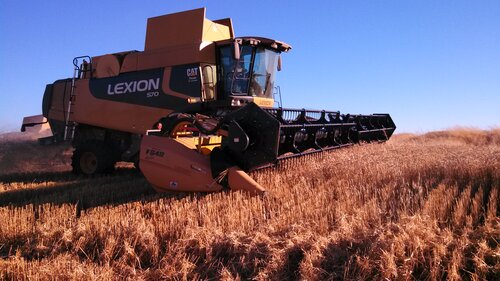Development of Improved Winter Wheat Cultivars for Western Canada

Robert Graf, a research scientist with Agriculture and Agri-Food Canada, Lethbridge Research and Development Centre, is developing improved Canada Western Red Winter (CWRW) wheat varieties for Western Canada.
Winter wheat acreage is relatively small, he says, so before he proposes a new variety for registration he wants to be sure it will really make an impact for producers. “Having a huge number of varieties is not going to serve anyone if we’re not making improvements,” he explains.
In his new varieties, he’s targeting resistance to the priority-one diseases—rusts (stem, leaf, and stripe), Fusarium head blight (FHB), and common bunt—but he’s also looking to add resistance to the wheat curl mite (which provides protection against wheat streak mosaic virus) and resistance to the Russian wheat aphid (which is a problem in some parts of the US and presented a scare in Western Canada in the late 1980s).
Wheat stem sawfly is another insect pest on his radar. Sawfly has long been an issue in spring wheat, but it hasn’t been a problem in winter wheat in Canada. Graf says there are populations of sawfly in the US that have synchronized their life cycles with winter wheat and have become a major problem as close as Montana, so he’s developing solid-stem varieties that will be inhospitable to sawfly.
His highest agronomic priorities are higher yield and winter survivability. “With climate change, we’re seeing a lot more variability in our extremes,” he says. “Some suggest that, over time, we may not need the level of winter hardiness that we currently strive for, but in the short and medium term, we need to maintain that excellent level of cold tolerance to reduce production risk.”
He’s also working to increase yield by up to 18% over CDC Buteo. He says, “that’s a stretch goal, but we’re definitely going to be able to approach it, and actually exceed it in some areas.”
AAC Network, a milling quality variety that has high protein, will be available this fall. Graf says, “It has the most complete disease resistance package of any winter wheat variety available.”
It also appears to have improved drought tolerance, which Graf says is something he’s going to be watching over the next couple of years. “This variety works in all areas of Western Canada,” he says, “but it seems to be best adapted—where we see the biggest jump in yield over other varieties—for southern Alberta.”
In 2020, he received support for a new, as yet unnamed, variety known as W583. He sees W583 as a potential replacement for Emerson, one of its parents. Ten years ago, Emerson was quite a breakthrough, explains Graf. It was the first variety in Canada rated resistant to FHB, and it had good resistance to the rusts, but that resistance came at somewhat of a cost in terms of yield.
“We’ve been working really hard to maintain that disease resistance and increase yield,” he says. W583 is the first result of these efforts and will be registered with a name this spring.
In 2021, he received support to register W601, which he describes as a “really exciting variety that looks like a breakthrough in yield.” In registration trials, it yielded significantly higher than all the checks and well over 20% more than CDC Buteo in some areas.
Next year he expects to get support for another variety that’s showing yield similar to AAC Wildfire, but has a more complete disease resistance package.
This Wheat Cluster project received funding from Agriculture and Agri-Food Canada through the AgriScience Program, which is part of the Canadian Agricultural Partnership, a federal, provincial, territorial initiative. This project also received funding from Alberta Wheat Commission, Saskatchewan Winter Cereals Development Commission, Western Grains Research Foundation, and Winter Cereals Manitoba.
To read the project profile, CLICK HERE.